Garlic mustard (Alliaria petiolata), is an obligate biennial herb of the mustard family (Brassicaceae). Seedlings emerge in spring and form basal rosettes by midsummer. Immature plants overwinter as basal rosettes that stay green and continue to grow during snow-free periods when temperatures are above freezing.
This is an excerpt from the Wild Ones Journal
Current members can log in to read the latest issue or check out the Journal Archives.
All plants that survive the winter produce flowers in their second year, regardless of size, and subsequently die. An average plant produces 400-500 seeds that germinate readily. Maximum production on one plant with 12 stems is estimated at 7,900 seeds. Once dormancy has been broken, seeds will germinate in both light and dark.
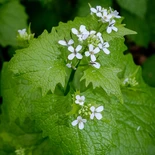
Garlic Mustard(Alliaria petiolata)
Garlic mustard invades forested communities and edge habitat. A native of Europe, the plant has no known natural enemies in North America, is self-fertile and is very difficult to eradicate once established. Thus the best and most effective control method for garlic mustard is to prevent its initial establishment.
Methods of dealing with Garlic Mustard
In shaded and partially shaded communities lacking garlic mustard, the preferred method is to monitor annually, and remove all plants prior to seed production. Once it is established, the management goal is to prevent seed production until the seed bank is depleted, potentially two to five years. Cutting of flowering stems at ground level provides the most effective control with minimal or no side effects, but has a high labor cost. Burning and herbicide application both provide control at a lower labor cost, but each has potential drawbacks: fire without sufficient fuel may be too cool to have an effect and may actually increase the total presence of garlic mustard, fire that is too hot may alter ground-layer composition; and herbicides may have a negative impact on some native groundlayer species. The method of choice depends on the size of the infestation, the type of community invaded, and the workforce available. In all cases, control must be continued annually until the seed bank is exhausted.
Toward exhausting the seed bank, corn gluten may be considered for some situations. The herbicidal action of corn gluten does not prevent germination, so the seed bank does suffer depletion. The presence of corn gluten prevents the establishment of secondary roots on seedlings which then die from lack of moisture and nutrients.
Another method of dealing with garlic mustard being discussed by members of the Iowa Native Plant Society involves intensive over-planting of moderately infested areas with shade-tolerant, fast-growing native plants. Jesse Bennett, of Driftless Land Stewardship in Glen Haven, Wisconsin, has submitted a most extensive list. Jewelweed (Impatiens capensis and Impatiens pallida), wood nettle (Laportea canadensis), stinging nettle (Urtica dioica), galiums (especially aparine, asprellum, triflorum) compete nicely against it she says. Yellow and wood violets (Viola pubescens and V. papilionacea), white vervain (Verbena urticifolia), stickseed (Hackelia virginiana), and waterleaf (hydrophyllum virginicum) all hold their own rather well.

Jewelweed(Impatiens capensis)

Pale Touch-Me-Not(Impatiens pallida)

Canadian Woodnettle(Laportea canadensis)

Stinging Nettle(Urtica dioica)

Stickywilly(Galium aparine)
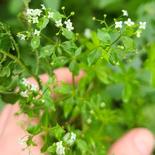
Rough Bedstraw(Galium asprellum)

Fragrant Bedstraw(Galium triflorum)
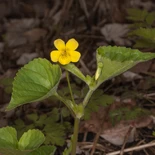
Downy Yellow Violet(Viola pubescens)

Common Blue Violet(Viola sororia)
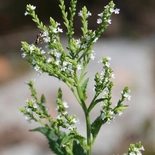
White Vervain(Verbena urticifolia)
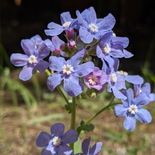
Beggarslice(Hackelia virginiana)

Eastern Waterleaf(Hydrophyllum virginianum)
She also suggests lopseed (Phryma leptostachya), jumpseed (Polygonum virginianum), honewort (Cryptotaenia canadensis), cow parsnip (Heracleum maximum), green headed coneflower (Rudbeckia laciniata), and native ferns, especially ostrich (Matteuccia struthiopteris), interrupted (Osmunda claytoniana), lady (Athyrium filix-foemina). Carex grisea, C. blanda, C. rosea, and C. pensylvanica, and grasses Elymus virginiana, E. riparius, E. villosus and E. hystrix and again the ferns, especially interrupted (O. claytoniana) will contribute to the fuel bank for a hotter burn.

American Lopseed(Phryma leptostachya)
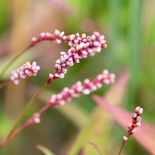
Jumpseed(Polygonum virginianum)
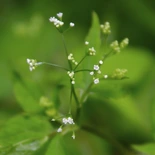
Canadian Honewort(Cryptotaenia canadensis)
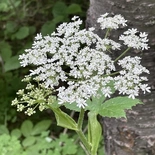
Common Cowparsnip(Heracleum maximum)

Cutleaf Coneflower(Rudbeckia laciniata)

Ostrich Fern(Matteuccia struthiopteris)
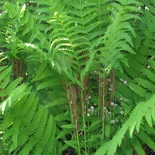
Interrupted Fern(Osmunda claytoniana)
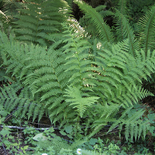
Common Ladyfern(Athyrium filix-femina)

Inflated Narrow-Leaf Sedge(Carex grisea)

Eastern Woodland Sedge(Carex blanda)

Rosy Sedge(Carex rosea)

Southeastern Wildrye(Elymus glabriflorus)

Riverbank Wildrye(Elymus riparius)

Hairy Wildrye(Elymus villosus)

Eastern Bottlebrush Grass(Elymus hystrix)

Interrupted Fern(Osmunda claytoniana)
Biological control for this species is in development. Berndt Blossey of Cornell is coordinating a project in Europe that started by testing 69 weevils that feed on various parts of the garlic mustard plant. The search has been narrowed to four weevils that appear to feed only on garlic mustard. Once their feeding habits are determined and USDA standards are met they will be introduced into the United States for continued testing.
Whether you pull it, cut it, burn it, or use a herbicide, each action that you take must be understood and carefully timed. Garlic mustard is not a plant that easily gives up the ghost. In any control efforts, several critical idiosyncrasies of the plant must be kept in mind for efficiency’s sake:
- The ground level area of the S-shaped section of the taproot must be removed in its entirety, or the plant will resprout from this section. Any damage to the primary flower stem stimulates growth of additional stems from axillary buds at the stem base and along the root crown. So just picking off the flowers to prevent seed set is not enough.
- Once the flowers have opened the plant nolonger needs to be attached to the root in orderto set seeds.As long as the flowers have access to sugars stored in the stem they can continue to achieve their goals. Therefore it is imperative to bag and send the pulled plants to the landfill. Most compost piles do not heat up enough to kill the seeds.
- Individual plants can continue producing flowers at leaf axils into August. Because of this long blooming time, constant monitoring is necessary.
- An infestation of garlic mustard spreads out from the core through multiple small populations. When a choice must be made whether to attack the core group or the outlying small numbers, most experienced stewards say “go for the outliers” and try to limit the spread.
Vigilance. There is no other way to say it. Keep checking back when you think you are rid of it.
Impacts of Garlic Mustard
Garlic mustard displaces native species of plants by several means. Several compounds isolated from garlic mustard have been shown to depress growth of both grasses and forbs in laboratory experiments. Researchers concluded that release of these phytotoxic compounds from garlic mustard root systems might account for its dominance in forest ecosystems.
In a May 2006 peer-reviewed publication, researchers report that garlic mustard interrupts the mutually beneficial relationships that many forest trees have with specifically arbuscular mycorrhizal fungi (AMF) by interfering with germination of fungal spores. Tree seedlings depend strongly on AMF. The researchers comment: “By killing off native soil fungi, the appearance of this weed in an intact forest could stifle the next generation of dominant canopy trees. It could also invite other native and non-native weedy plants that currently grow in low-AMF habitats, such as those disturbed by logging or development.”
The researchers plan to study which phytochemicals in garlic mustard may kill AMF, how these chemicals interact with other beneficial soil microbes, and how plants and fungi in garlic mustard’s native European habitat coexist with the noxious species.
By Maryann Whitman

